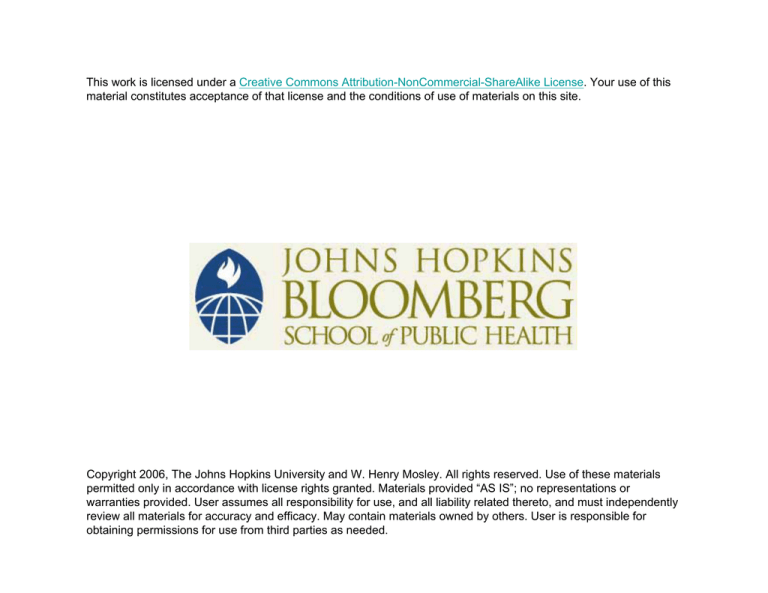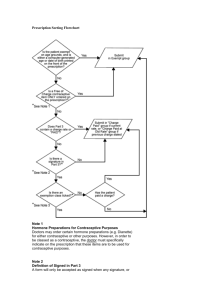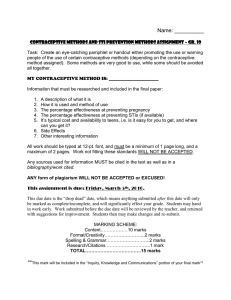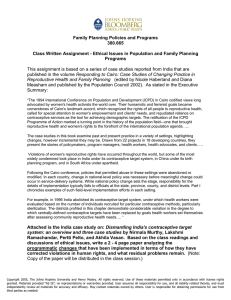
This work is licensed under a Creative Commons Attribution-NonCommercial-ShareAlike License. Your use of this
material constitutes acceptance of that license and the conditions of use of materials on this site.
Copyright 2006, The Johns Hopkins University and W. Henry Mosley. All rights reserved. Use of these materials
permitted only in accordance with license rights granted. Materials provided “AS IS”; no representations or
warranties provided. User assumes all responsibility for use, and all liability related thereto, and must independently
review all materials for accuracy and efficacy. May contain materials owned by others. User is responsible for
obtaining permissions for use from third parties as needed.
PFHS-380.665 FAMILY PLANNING POLICIES AND PROGRAMS
Paying for Family Planning:
Costs, Cost Recovery, and Cost-effective Investment Strategies
W. Henry Mosley
A. Why subsidize family planning services? (Ref: Lewis, M., 1986)
Reduced fertility has high social benefits as well as individual benefits. But even
though individuals have a desire for fewer children, their “demand” for family
planning is constrained by their resources, both material (money) and nonmaterial (time, knowledge, beliefs, values, etc.). Because of these constraints,
the free market price for contraceptives will generally not meet the social welfare
objective. Therefore government subsidies are required to equalize individual
and social preferences.
B. What are the User “costs”?
1. Search costs for acquiring correct information
a. about methods
b. about reliable and trustworthy sources of supply
2. Time costs
a. travel (including multiple trips for closed/empty clinics)
b. waiting times for services
3. Method variety costs (not getting choice)
a. limited methods available
b. provider biases
c. provider incompetence (technical)
4. Administrative costs
a. age, parity, marriage requirements; spousal consent
b. needless examinations
c. regulatory/bureaucratic restrictions
d. unpleasant/unfriendly environment (lack of privacy)
5. Social/cultural costs
a. cultural insensitivity (no female providers)
family opposition
6. Health and psychic costs
a. anxiety due to contravening cultural norms
b. physical side effects of the contraception
7. Monetary costs
a. for travel
b. for services
c. for commodities
1
C. What are usual provider costs? (Ref: Barberis and Harvey, 1997)
Mode of service delivery
Social marketing
Sterilization
Clinic services with
sterilization
Clinic services without
sterilization
Community-based distribution
Clinic services with CBD
D.
Average Cost per CYP
US$
2.14
1.85
3.89
6.10
9.99
14.00
What is Elasticity of Demand to Price Changes?
Definition: The price elasticity of demand for a good is the proportional change
in the quantity demanded of the good relative to the proportional change in the
price.
Example: Matheny (2004) cites 5 studies of the overall price elasticity of demand
for contraceptives which showed elasticities in the range of 0 to 0.15. That is, for
every 100% increase in the mean price of contraceptives, the contraceptive use
decreased by 0% to 15%.
Price elasticity is influenced by many factors including:
1.
Type of contraceptive
2.
Initial price versus cumulative cost
3.
The role of substitutes
4.
Non-monetary costs
5.
Economic situation
6.
Perceptions of value
E.
What is the cost-effectiveness of investments in alternative interventions to
improve FP use? (Matheny, 2004)
1. Depends on the elasticity of alternative investment strategies – e.g., what will
be the proportional change in FP use with a given investment in a FP strategy?:
2. For the most part, data are very poor or not available at all.
3. Where data are available, Matheny (2004) provides the following estimates:
a. The low elasticities of contraceptive demand with contraceptive price
subsidies (as summarized above) lead to an estimate of $61 per couple
year of protection in Indonesia, if investments are just made in price
subsidies.
b. Media campaigns in Egypt, Turkey, and Zimbabwe have given
estimates of $3.26, $1.36 and $3.57 per CYP.
c. Strategies to improve quality appear to be very cost-effective, but
good empirical data are lacking.
2
F.
Social Marketing – Engaging the private sector to promote and distribute a
“public good”.
Definition: the design, implementation, and control of programs calculated to
influence the acceptability of a social idea and involving considerations of product
planning, pricing, communications, distribution, and market research.
1.
2.
3.
Contraceptive social marketing:
a.
uses existing commercial/retail channels
b.
subsidizes prices (by government/donors) or recover partial costs
to:
achieve high distribution
reach low income groups
Coverage and costs
Issues
a.
management must fit local circumstance
examples of managers
family planning organizations
private sector organizations established specifically
for CSM
quasi-governmental agencies
government agencies
b.
potential customers
market segmentation
c.
products
condoms, orals, spermicides, IUDs, injectables
d.
pricing
a balance between assuring wide availability, retailer
profitability and cost recovery
e.
promotion
promote products (brands) and providers
target promotion to consumers and providers
continuous promotion
f.
evaluation
sales
couple-year-of-protection (CYP)
coverage
cost/CYP
3
Required Readings:
Haws J, Bakamjian L, Williams T, Lassner KJ. Impact of sustainability policies on
sterilization services in Latin America. Studies in Family Planning 23(2):8596, March/April, 1992.
Janowitz B, Suazo M, Fried DB, Bratt JH, Bailey PE. Impact of social marketing
on contraceptive prevalence and cost in Honduras. Studies in Family
Planning 23(2):110-117, March/April 1992.
Schuler, SR, Bates, L, Islam, MK. Reconciling cost recovery with health equity
concerns in a context of gender inequality and poverty: findings from a
new health initiative in Bangladesh. International Family Planning
Perspectives 28: 196-204, 2002.
Supplementary Readings
Matheny, G., Family planning programs: getting the most for the money.
Internatinal Family Planning Perspectives 30 (3): 134-138, 2004.
Meekers, D, and Rahaim, S. The importance of socioeconomic context for social
marketing models for improving reproductive health: Evidence from 555
years of program experience. BMC Public Health 5:10, 2005 (available at
http://www.biomedcentral.com/1471-2458/5/10)
Recommended Readings:
Barberis M and Harvey PD. Cost of family planning programmes in fourteen developing
countries by method of service delivery. Journal of Biosocial Science 29: 219223, 1997.
Bratt JH, Forheit J, Vargas T. Three strategies to promote sustainability of CEMOPLAF
clinics in Ecuador. Studies in Family Planning 29(1): 58-68, 1998.
De Silva V, Thapa S, Wilkens LR, Farr MG, Jayasinghe K, McMahan JE.
Compensatory payments and vasectomy acceptance in urban Sri Lanka.
Journal of Biosocial Science 20(2):143-156, 1988.
Forheit KG, and Levine R. Cost recovery and user fees in family planning. Policy Paper
Series No. 5. OPTIONS for Population Policy II, The Futures Group, Washington,
DC, 1993
Gillespie DG, Cross HE, Crowley JG, and Radloff SR. Financing the delivery of
contraceptives: the challenge of the next twenty years. Pages 265-295 in SJ
Segal, AO Tsui and SM Rogers (eds) Demographic and Programmatic
Consequences of Contraceptive Innovations. New York and London: Plenum
Press, 1989.
Harvey PD. The impact of condom prices on sales in social marketing programs.
Studies in Family Planning 25(1):52-58, January/February 1994.
4
Hubacher D, Cardenas C, Hernandez D, Cortes M, Janowitz B. The costs and benefits
of IUD follow-up visits in the Mexican Social Security Institute. International
Family Planning Perspectives 25(1): 21-26, 1999.
Huber SC and Harvey PD. Family planning programmes in ten developing countries:
cost effectiveness by mode of service delivery. Journal of Biosocial Science
21:267-277, 1989.
Janowitz B, Nunez J, Covington D, Colven C. Why women don't get sterilized: a followup of women in Honduras. Studies in Family Planning 16(2):106-112, 1985.
Janowitz B, Chege J, Thompson A, Rutenberg N, and Homan R. Community-based
distribution in Tanzania: Costs and impacts of alternative strategies to improve
worker performance. International Family Planning Perspectives 26(4): 193-195,
2000.
Knodel H, Bennett T, Panyadilok S. Do free pills make a difference? Thailand's
experience. International Family Planning Perspectives 10(3):93-97, 1984.
Lande RE and Blackburn R. Pharmacists and family planning. Population Reports
Series J, Number 37. Baltimore, MD: The Johns Hopkins University Center for
Communication Programs, November 1989.
Lande RE and Geller JS. Paying for family planning. Population Reports, Series J,
Number 39. Baltimore, MD: The Johns Hopkins University Center for
Communication Programs, November 1991.
Lewis MA. Do contraceptive prices affect demand? Studies in Family Planning
17(3):126-135 May/June, 1986.
Lewis MA. Cost recovery in family planning. Economic Development and Cultural
Change 35(1):161-182, October, 1987.
Mitchell MD, Littlefield J, and Gutter S. Costing reproductive health services.
Internatonal Family Planning Perspectives. 25 (Supplement): S17-S21 & S29,
1999.
Population Information Program. Contraceptive social marketing: lessons from
experience. Population Reports Series J, Number 30. Baltimore, MD: The
Johns Hopkins University Center for Communication Programs, July-August
1985.
Robinson W, Cleland J. The Influence of Contraceptive Costs on the Demand for
Children. Pages 106-122 in JF Phillips and JA Ross (eds) Family Planning
Programs and Fertility. New York: Clarendon Press Oxford, 1992.
Ross JA and Isaacs SL. Costs, payments, and incentives in family planning programs:
a review for developing countries. Studies in Family Planning 19(5):270-283,
September/October 1988.
Sheon A, Schellstede W, and Derr B. Contraceptive social marketing. Pages 367-390
in RJ Lapham and GB Simmons (eds) Organizing for Effective Family Planning
Programs. Washington, D.C.: National Academy Press, 1987.
Simmons GB, Baik D, and Faiz KK. A cost effectiveness analysis of family planning
programs in rural Bangladesh: evidence from Matlab. Studies in Family Planning
22 (2): 83-101, 1991.
Thapa S, Abeywickrema D, and Wilkens LR. Effects of compensatory payments on
vasectomy acceptance in urban Sri Lanka: a comparison of two economic
groups. Studies in Family Planning 18(6):352-360, November/December, 1987.
5
Tsui AO and Donaldson PJ. The role of private physicians and clinics in Third World
family planning. Pages 391-411 in RJ Lapham and GB Simmons (eds)
Organizing for Effective Family Planning Programs. Washington, D.C.: National
Academy Press, 1987.
Vach TH, Bishop A, Hoa VT, Hien LX, Chien TD, and Nguyen TI. The potential impact
of introducing pregnancy testing in menstrual regulation services in Vietnam.
International Family Planning Perspectives 24(4): 165-169, 1998.
Winfrey, W, Healton, L, Fox, T, Adamchak, S. Factors Influencing the Growth of the
Commercial Sector in Family Planning Service Provision. Working Paper Series
No. 6, The POLICY Project, 2000.
http://www.policyproject.com/pubs/workingpapers/wps-06.pdf
6







